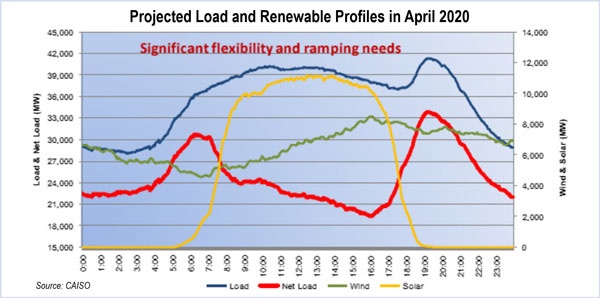By Robert Mullin
FERC last week approved CAISO’s plan to implement a new market mechanism designed to improve the real-time integration of the increasing volume of variable renewable energy resources coming on to the ISO’s system (ER16-2023).
The flexible ramping product will also be incorporated into the CAISO-run Western Energy Imbalance Market.
The product will enable the ISO to procure resources equipped to quickly respond to dispatch orders and ramp output up or down in response to swings in forecasted net load between five-minute real-time market intervals.
Net load is the ISO’s gross load forecast minus output from intermittent wind and solar resources. The new product will also allow the grid operator to procure additional ramping capability to account for uncertainty in its forecasts.
The mechanism is intended to help CAISO prevent power balance violations that can result from mismatches between generation and load, a growing risk as California moves toward fulfilling its mandate to generate 50% of its electricity from intermittent renewable resources by 2030.
The procurement of ramping capability will be bundled into the real-time energy market run, rather than being administered through a separate bidding process. Under the mechanism, load or supply resources that increase the need for ramping capability between real-time market intervals will be charged for the flexible ramping product, while resources that decrease the need will receive a payment.
“Settling ramping capability directly between load or supply resources that consume ramping capability and those that provide ramping capability will help manage the ramping need by incentivizing load-serving entities to have a portfolio of both dispatchable and non-dispatchable resources that can follow their load profile,” CAISO said in its proposal.
The ISO says the ramping product is readily dispatchable, distinguishing it from an ancillary services product for standby “unloaded” capacity withheld from the market.
The product replaces CAISO’s flexible ramping constraint, an interim measure implemented in 2011 to ensure upward ramping capability of dispatchable resources in the 15-minute real-time unit commitment process.
That measure enabled the ISO to reserve uncommitted ramping capability from dispatchable resources that were not designated to provide contingency or regulation reserves and whose upward ramping capability was not forecast to be needed to meet real-time loads.
The new product addresses the ISO’s need for shorter dispatch intervals and downward ramping capability.
Bidding Process Rejected
In its ruling, the commission rejected a request by the Western Power Trading Forum, the Electric Power Supply Association and the Independent Energy Producers Association to subject procurement of the flexible ramping product to a bidding process similar to that used for ancillary services.
“That the flexible ramping product may meet the definition of an ancillary service, or be similar to other ancillary services, such as spinning reserves or regulation, does not require that CAISO procure it in the same manner as those other products,” the commission wrote.
FERC also denied a request by the Six Cities municipal utilities — Anaheim, Azusa, Banning, Colton, Pasadena and Riverside — that it condition its approval of the product proposal on successful completion of market simulations. The commission said the ISO already stated that it would not roll out the product until it completed simulations and addressed market participants’ concerns.
The commission rejected as beyond the scope of the proceeding a request by the California Energy Storage Alliance to lower the ramping product’s -$150 bid floor.
On Sept. 28, CAISO petitioned the commission to delay the effective date for the product implementation by one month until Nov. 1. The ISO said that it didn’t learn of FERC’s decision until hours after a Sept. 26 call scheduled to confirm the roll-out to market participants. A decision on the petition is pending.





